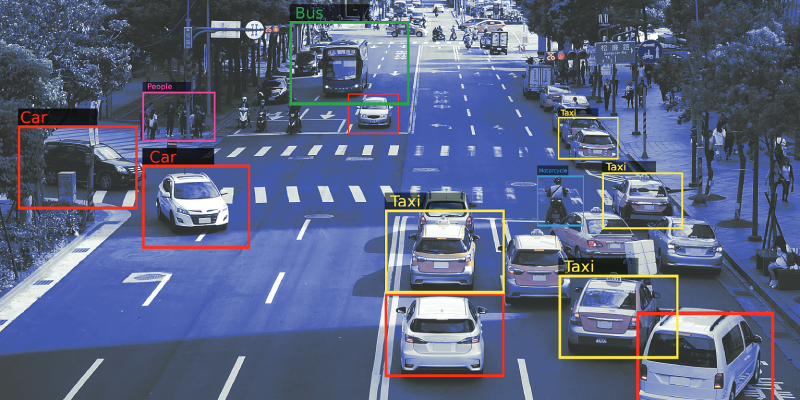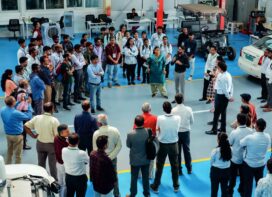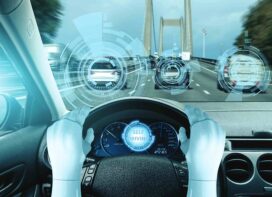A silent revolution is underway on India’s busy, clamorous roads. Several city civic bodies and various other government organizations are investing in deployment of Intelligent Traffic Management Systems (ITMS) powered by artificial intelligence (AI). TrafficInfraTech examines how these technologies are likely to improve travel safety, reduce travel-stress, and transform the overall travel experience for the citizens in India.

Little must anyone have thought that the Smart Cities Mission program launched by the Government of India in January 2016 would harbinger a technology-driven revolution in India within a few years. In the beginning of 2016, India’s Prime Minister Narendra Modi, along with the then urban development minister M Venkaiah Naidu launched an ambitious-looking Smart Cities Mission program aimed at transforming the state of public infrastructure in 100 Indian cities and thereby improving the quality of life for citizens.
Although introduced with much fanfare, the program was received with deep doubt and skepticism about its effective implementation at the ground level. Reports appeared in the media till the last year suggesting how the project had fallen short of people’s expectations.
Fast forward to June 2022, the same Smart Cities Mission is being viewed in a different light today. Reports started appearing about the project completing important milestones. When it comes to transforming road traffic management in India, the Smart Cities Mission project is being seen as the right policy move today.
Speedy Developments
Already, several municipalities in India—urban and semi-urban—have readied their plans to invest in artificial intelligence (AI) driven intelligent road traffic management systems under Smart Cities Mission. For instance, Madurai City Corporation, has announced its plan to roll out a smart traffic management system. The objectives will be to minimize traffic congestion, deter illegal parking, and bring automation in traffic lights. The municipality also plans to create a command and control room for centralized traffic monitoring and management with the help of video surveillance feeds and artificial intelligence.
Similarly, Shimla Municipal Corporation too is in the process of deploying an Intelligent Traffic Management System (ITMS) powered by AI. CCTV cameras will be installed at 88 important traffic nodes across places such as Bishop Cotton School, Dhalli, Navbahar, Totu, and Tutikandi in the city. Besides monitoring vehicular traffic movement to achieve decongestion, the city civic body also aims at making road travel safer by bringing traffic violators to book.
Madurai and Shimla are not the only two cities investing in ITMS. Smart City Mission is providing a boost to the adoption of AI powered traffic management all over India. The municipalities of Amritsar, Bhubaneswar, Chennai, Guntur, Jammu, Kolkata, Noida, Srinagar, Silvassa, and Udaipur also have publicized similar plans.
At the national level, the National Highways Authority of India (NHAI) is reportedly testing an Advanced Traffic Management System (ATMS) to provide on demand information on aspects such as registration and pollution control certificate of vehicles to the authorities that need such information.
 Shailendra Kumar Singh, Head – Smart & Safe City Business, Vehant TechnologieGaurav Nagariyas, informs that nearly 75 Indian towns have started rolling out plans of intelligent traffic management system implementations. “Intelligent traffic management appears to be the priority area for all municipalities under Smart City Mission. Vehant is participating in more than 40 such Smart City projects already.” Incubated by Indian Institute of Technology (IIT) Delhi, Vehant is into AI / ML – based solutions for traffic monitoring and junction enforcement besides other application areas.
Shailendra Kumar Singh, Head – Smart & Safe City Business, Vehant TechnologieGaurav Nagariyas, informs that nearly 75 Indian towns have started rolling out plans of intelligent traffic management system implementations. “Intelligent traffic management appears to be the priority area for all municipalities under Smart City Mission. Vehant is participating in more than 40 such Smart City projects already.” Incubated by Indian Institute of Technology (IIT) Delhi, Vehant is into AI / ML – based solutions for traffic monitoring and junction enforcement besides other application areas.
Down to the brass tacks
ITMS involves a play of technologies at two levels—the advanced driver assistance systems (ADAS) inside the vehicle and the technologies that augment road infrastructure. ADAS incorporates a range of technologies including adaptive cruise control, adaptive light control, automatic parking, navigation system, blind spot monitoring, driver drowsiness detection, telematics, and onboard diagnostics. The next technological evolution in this field will be autonomous cars (self-driving cars). While some vehicle-specific systems are in use at present, their adoption is still at a nascent stage. A few technologies such as navigation system, however, are in use today.
While a range of technologies are employed in ITMS, video data capture and AI powered analytics of traffic data feeds have emerged as critical components of the modern day traffic management and violation detection systems. These technologies include speed enforcement cameras (radar speed gun based), automatic number plate recognition (ANPR) cameras, closed circuit TV (CCTV) cameras, high speed network (fiber and wireless), centralized control center, and the core AI system.
Applications (and benefits) of ITMS
According to the latest available statistics from the Ministry of Road Transport and Highways, nearly 3.66 lakh road accidents occurred in India in the year 2020 resulting in death of about 1.31 lakh persons and causing injuries to 3.48 lakh persons. The report cites traffic rules violation as the primary reason behind these incidents.
 “India is among the countries with the highest number of road accidents. Pedestrian movement on roads and traffic violations due to driver negligence and poor driving skills are the major causes of road accidents in India,” comments Gaurav Nagariya, Senior Technical Consultant, SynergyLabs Technology, Gurgaon. SynergyLabs specializes in computer vision, machine learning, and intelligent video surveillance solutions, among other technologies.
“India is among the countries with the highest number of road accidents. Pedestrian movement on roads and traffic violations due to driver negligence and poor driving skills are the major causes of road accidents in India,” comments Gaurav Nagariya, Senior Technical Consultant, SynergyLabs Technology, Gurgaon. SynergyLabs specializes in computer vision, machine learning, and intelligent video surveillance solutions, among other technologies.
Through AI technology, intelligent traffic management systems aim at making road travel safer and stress-free for everyone. This involves use of a range of applications as below.
-
Automatic traffic violation detection
A range of driver-actions are regarded as traffic violations. Some of the commonly found violations are over-speeding, improper lane change, wrong-side driving, driving without seat-belt, riding without helmets (two-wheelers), drunken driving, using mobile phone while driving, etc. AI software at the ITMS backend interprets videos streams received from the high-resolution radar speed guns, CCTV cameras, and ANPR cameras and accurately spots each of these violations in real time.
The AI powered system not only raises alerts every time a traffic violation is detected, but also provides supporting video evidence and issues challan automatically. The violator is intimated about the same through an SMS sent to his/her mobile phone immediately. This way, AI helps curb such incidents making road travel safer for everyone.

Over-speeding: Video-still depicting over-speeding detection along with the license plate details captured from camera footage
-
Automatic number plate recognition (ANPR)
Another useful AI driven feature is automated number plate recognition (ANPR) with the help of specialized cameras that can capture license plate information with high accuracy.
 “AI along with ANPR feeds opens up multiple possibilities from traffic management perspective. Capturing the license plate details helps you know vehicle types (trucks, two-wheelers, cars, etc.), vehicle registration year, current owner’s name, age of the vehicle, and so on,” opines K Srinivasan, Director and CEO, AllGoVision Technologies, Bengaluru.
“AI along with ANPR feeds opens up multiple possibilities from traffic management perspective. Capturing the license plate details helps you know vehicle types (trucks, two-wheelers, cars, etc.), vehicle registration year, current owner’s name, age of the vehicle, and so on,” opines K Srinivasan, Director and CEO, AllGoVision Technologies, Bengaluru.
“This information can be used in many ways: What is the history of traffic violations for this particular vehicle, is it too old and nearing its end of life, etc., can be brought to light,” he explains.
AllGoVision uses the ANPR camera feeds to gauge vehicle speeds to detect over-speeding. The traffic police has traditionally been using radar speed guns to measure vehicle speeds. While the radar-based detection systems assure nearly 2 kmph error margin, ANPR feeds can deliver accuracy with up to 5 kmph error margin. Although this may not be applicable on public roads, the technology can
be of great help in private campuses such as universities, manufacturing plants, large residential colonies, defense colonies, etc., Srinivasan informs.
AllGoVision has carried out one such implementation at a plant in Odisha to detect speed limit violations by vehicles running inside the campus. The company has deployed 20 cameras across the plant’s campus roads. “Our system gauges the speeds at which the vehicles are running and raise alerts whenever any vehicle is found over-speeding.”

Alarm center: This screenshot reflects all the real-time alarms for the violation of speed along with the vehicle license plate captured
 Commenting on the accuracy level of ANPR systems, Anand Shankar, Director – Planning, Advisory and Business Development, DataCorp Traffic, Bengaluru, informs that these cameras can provide up to 90 percent accuracy as of today. DataCorp specializes in AI powered solutions that provide intelligence at three levels:
Commenting on the accuracy level of ANPR systems, Anand Shankar, Director – Planning, Advisory and Business Development, DataCorp Traffic, Bengaluru, informs that these cameras can provide up to 90 percent accuracy as of today. DataCorp specializes in AI powered solutions that provide intelligence at three levels:
- Intersections: Red light and driver violations, yellow box analysis, people movement, hot spot identification
- Mid-block: Lane utilization, detection of traffic violations related to over-speeding, helmet, seat belt, etc.
- People movement: Crowd management, identifying hot spot areas on high streets, etc.
The company provides traffic intelligence to National Highways Authority of India while working with large infrastructure implementation players. It is currently working on such projects in Rajasthan and Gujarat.
-
Smart traffic lights
In this technology, the AI powered system monitors and measures the volume of traffic on a highway as well as different city roads. The system intelligently switches signals to red, green, or yellow in order to ease the traffic load on specific road-stretches wherever traffic congestion is likely to occur. This way, all the busy streets are kept clear of congestion.
 Agastya Bellad, CEO, Beltech Artificial Intelligence, Bengaluru, informs that his company recently implemented a pilot project of smart traffic signal management system on Bengaluru’s Mahatma Gandhi Road in order to ease frequent traffic congestions.
Agastya Bellad, CEO, Beltech Artificial Intelligence, Bengaluru, informs that his company recently implemented a pilot project of smart traffic signal management system on Bengaluru’s Mahatma Gandhi Road in order to ease frequent traffic congestions.
“The pilot was successful in reducing the traffic load by more than 40 percent,” informs Bellad. Beltech’s system also helped the authorities to notify 1,200-plus violations per day.
-
Priority vehicle movement
While decongestion of roads is an important objective, another significant issue that AI addresses is assuring a faster, obstacle-free movement for specific classes of vehicles, such as ambulances, or vehicles on emergency service, or those carrying time-sensitive life-saving drugs, or the VIP vehicles. Nagariya of SynergyLabs informs that his company helps the authorities such as city civic bodies to create green corridors to expedite the movement of such vehicles. “For example, when an ambulance has to pass through, all the signals across its route turn green the moment it comes within a particular range,” Nagariya explains.
-
Smart street lights:
Lack of adequate street lights on Indian roads may put the lives of travelers at risk in the night. An AI powered system can intelligently switch on and off the street lights as per the need. This ensures that adequate light is available for drivers when necessary but lights can be automatically switched off wherever not needed, thus, saving electricity.
-
Law enforcement
While detecting traffic violations or reducing traffic congestion are the most crucial tasks for AI, there also are a few other areas where it can play an important role. For instance, the Bengaluru-based AI solution provider, CamfyVision Innovations, uses its technology for tax compliance enforcement through real time traffic monitoring.
 The Founder and CEO Vedpal Singh informs that his company’s AI solution Tejas 4.0 helps the Excise Department of Bihar state to curb tax evasion by businesses. “Our system is deployed at every state entry/exit point (check-posts). It monitors every vehicle that exits from and enters the state. It identifies each vehicle based on its number plate and classification (car, truck, or motorcycle, etc.) and notifies the authorities whenever any blacklisted vehicle is found.”
The Founder and CEO Vedpal Singh informs that his company’s AI solution Tejas 4.0 helps the Excise Department of Bihar state to curb tax evasion by businesses. “Our system is deployed at every state entry/exit point (check-posts). It monitors every vehicle that exits from and enters the state. It identifies each vehicle based on its number plate and classification (car, truck, or motorcycle, etc.) and notifies the authorities whenever any blacklisted vehicle is found.”
As an additional benefit, the same vehicle traffic intelligence also helps the Bihar state government to curb smuggling of liquor which is banned in the state.
In addition to the applications mentioned above, AI is also used for smart pothole tracking wherein vehicle-mounted sensors constantly monitor the road for potential ground-level obstructions such as potholes or stray objects like stones. However, its adoption has not happened in India in any significant way.

Bengaluru city ITMS pilot project implementation – At a glance
Future Scope
We are witnessing exciting times with rapid changes happening in India. The fact that India is still at the nascent stage of adoption of AI for ITMS, further points to a massive growth ahead.
According to a report by Fact.MR Research, the global intelligent traffic management system (ITMS) market was estimated to be $17.75 billion in 2021 and is expected to reach $34 billion by 2031, registering a firm, 6.7 percent growth. Although there are no third party market research estimates available in the public domain, the players involved in ITMS implementations believe that the market is growing at more than 100 percent rate annually.
In fact, the government of India now plans to expand the scope of Smart City Mission to cover 4,000 towns going forward. Net effect: these revolutionary changes will encompass the vast Indian heartland within a few years.
 TrafficInfraTech Magazine Linking People Places & Progress
TrafficInfraTech Magazine Linking People Places & Progress


